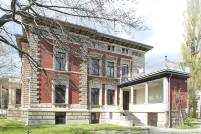The facade front is veneered with dark red clinker brick, the structural components such as corner blocks, cornices, window frames, portals and columns are made of sandstone. A frieze using the sgraffito technique can be seen under the main cornice of the flat roof.
The north facade with a pronounced central risalit and a balcony built on it faces the Ferdinand-Lassalle-Strasse (Elster flood basin). The west facade borders directly on Käthe-Kollwitz-Straße, originally Plagwitzer Straße.
The portico with the entrance gate is located in the center in the area of the south side of the building, above which you can see the original stained glass windows. On the east side there is a covered terrace / loggia.
In the stairwell and in the staircase to the mezzanine, the lower wall surfaces are decorated with Stuccolustro marble in Pompeian style. Also noteworthy is the representative staircase with art-forged neo-baroque balustrades. The large wall paintings in the stairwell were created in 1886 by the Leipzig art professor Arndt.
During the restoration work, several layers of decorative paintings were uncovered in the vestibule, the second and probably most beautiful version of which can be seen, only in the area to the right of the door to the bar room is a "window under monument law" with the first version of the wall painting. Also worth seeing is the stucco ceiling in the bar room, which is decorated with imitation wood in beer batter glaze, which was very popular when the villa was built.
